Let me show you how to use the tangzhong method to make pain au lait or milk bread. Tangzhong breads are soft and springy and stay that way for days. This milk bread made using the tangzhong method may be the best sandwich bread ever.
Another way to make bread that has great keeping properties is to make potato bread, so you might want to check that out as well.
For ease of browsing, here are all of my bread and roll recipes in one place. Thanks for visiting!
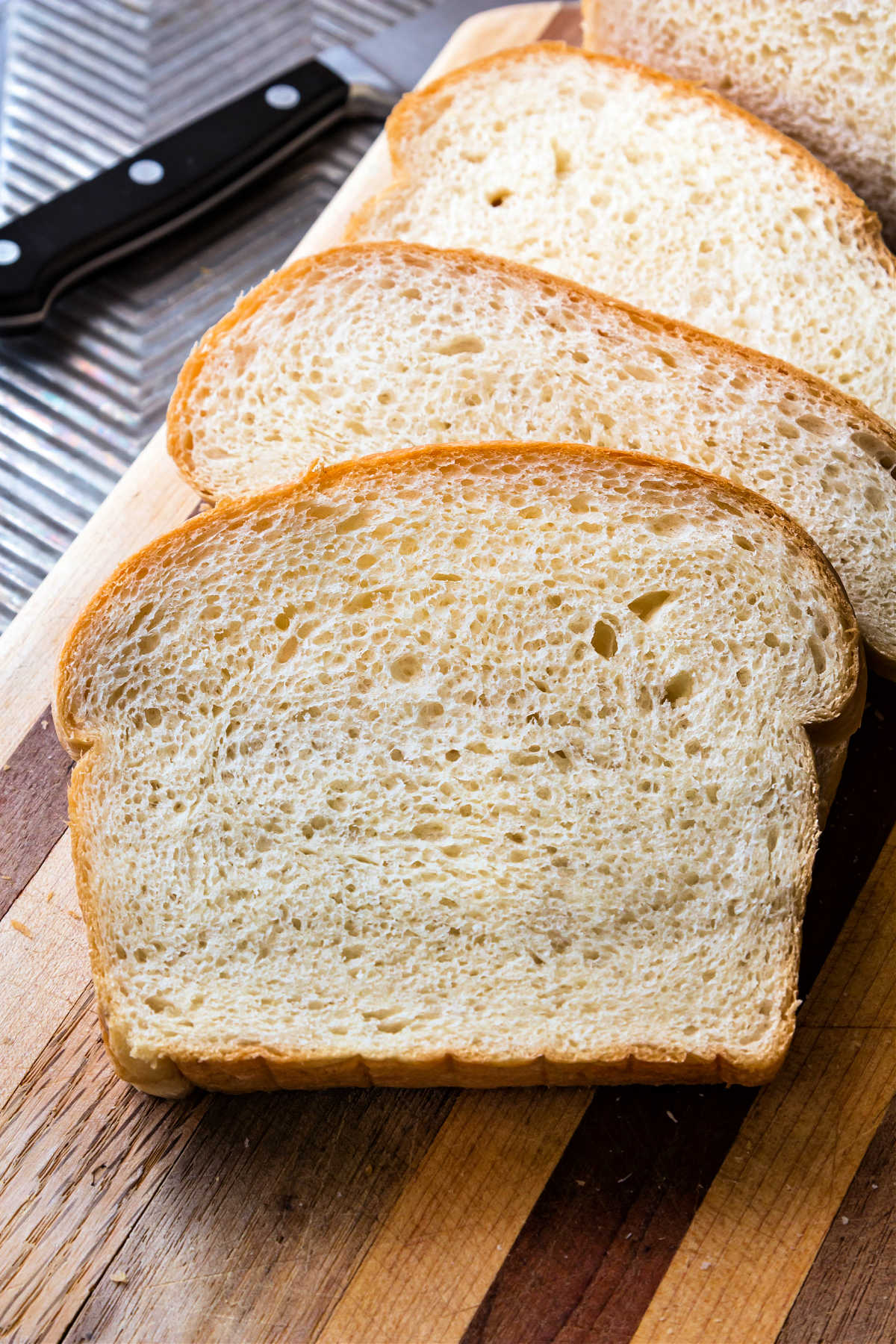
This is my favorite white bread recipe. Such a good flavor and texture. Worth all of the wait time during the kneading process!
Pinner Laura
Why Make Tangzhong Bread
If you are a fan of soft, springy sandwich bread, I’m pretty sure you can’t beat the Tangzhong method.
If you’re looking for hearty, chewy bread, this ain’t it, but seriously, you may never encounter a softer or sweeter white bread.
When I need a bread, butter, and sugar sandwich, this is the bread I use.
Pastry Chef Online Participates in Affiliate Programs. If you make a purchase through one of my links, I may earn a small commission. For more information click to read my disclosure policy
The Tangzhong gives this bread great keeping qualities, too.
This bread is for you if you like:
- Soft white bread
- Have a kiddo who will only eat white bread
- Can’t eat an entire loaf of bread in a day and don’t want to freeze it
- Bread with great keeping qualities without any artificial conditioners or additives
- Perfect toast, because this loaf toasts like a dream
What Is The Tangzhong Method
Tangzhong, or water roux, is a Japanese technique that was popularized in Asian countries by a Chinese cookbook author Yvonne Chen in a book called the 65°C Bread Doctor.
The method involves cooking a portion of the flour with a portion of the liquid in the recipe until the flour gelatinizes (thickens).
Then, this “roux” is added back to the rest of the ingredients.
Once I read about the method, I knew I wanted to try it. I put it forth on twitter that I was going to give it a go.
The supremely talented Stella, of BraveTart (more recently with Serious Eats), told me that she had used the method, which she learned in a Japanese bakery in Kentucky believe it or not, to develop a very special “kid bread” for her upcoming cookbook.
Incidentally, you can now grab a copy of the fantastic BraveTart: Iconic American Desserts at your favorite book store or through Amazon where you’ll find her recipe for “Wonder Bread” along with the best chocolate chip cookies anywhere.
What is Tangzhong?
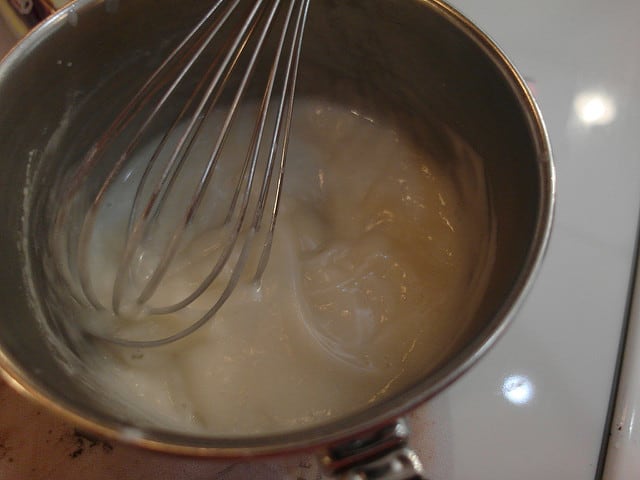
Tangzhong, or water roux, is a mixture of 1 part flour to 5 parts water, by weight, that you stir and cook until the starches in the flour gelatinize and the mixture thickens. This magically happens at 150°F, or 65°C.
After covering and cooling to warm, you simply add this tangzhong into your recipe.
Because the Tangzhong is made up of both flour and water, the two most abundant ingredients in bread making, it is added in place of a portion of the flour and water in your formula, not in addition to.
The amount of flour you use in the Tangzhong can vary from 5%-12% of the total amount of flour.
Once you’ve settled on the amount of flour, simply multiply the weight of the flour by five, and that’s the amount of water you’ll need. Easy.
How To Do The Math
Let’s say your original recipe calls for 10 oz of flour (for easy math purposes) and 7 oz of water and you want to substitute tangzhong for 10% (again, for easy math purposes) of the total weight of the flour:
- 10 oz x 10% = 1 oz
- 1 oz x 5 = 5 oz
This leaves you 9 ounces of “loose flour” (10 oz – 1 oz) and 2 ounces of “loose water” (7 oz – 5 oz).
Whisk together the 1 oz of flour and 5 oz of water and cook to 150°F (65ºC), cover and let cool to just warm.
Add the cooled tangzhong to your remaining flour and liquid, yeast and salt and continue with your bread recipe.
How Tangzhong Helps to Keep Bread Soft
When proteins–in this case, gluten–denature (unravel) in the oven and then cool off, they squeeze moisture out and form a sturdy, dry matrix.
In bread, this is called the crumb.
Crumb is affected by moisture, sugar and fat content as well, but when the moisture wanders off during staling, what is left is the hard protein matrix.
Once starches gelatinize and suck up moisture, which is one of the steps of the baking process: “Gelatinization of starches: 150°F”, they don’t let go of it. Water checks in, but it doesn’t check out.
So when the starch matrix sets up upon cooling, part of its very fabric is water. Unlike proteins which set up into a hard web–think loofah–starches set up more like a damp sponge.
With Tangzhong bread, you’re decreasing the amount of dry protein structure and increasing the amount of moist gelatinized starch structure.
How Does Tangzhong Work?
When it comes to making soft breads with good keeping properties, what good is water with gelatinized starch in it?
Bread is moist largely because of water content. The more water, the moister the bread. The longer the water stays in the bread, the longer the bread stays moist.
When you cook water and flour together until the starch granules swell up, what you’re basically doing is forming a gel in which the starches bind or hold onto the water.
And since the starches are all swelled up and dealing with the water, the proteins in the flour, glutenin and gliadin which normally bond to create gluten, are sidelined. So, what you are doing when you add tangzhong to a bread is two things
- you’re introducing a gel into the dough that will hold onto water far longer than in a standard dough and, even though you’re using the same total amount of flour,
- you’re inhibiting some of the gluten from forming, creating a more tender product.
Now, this is not to say that your bread will have less structure. It will just have a protein structure (thank you, gluten) as well as an extra-large portion of starch structure (thanks, Tangzhong).
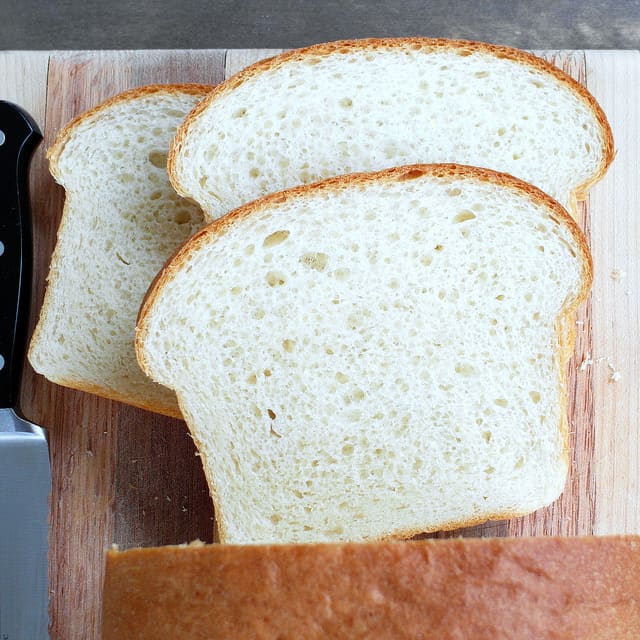
Pain au Lait with the Tangzhong Method
Once I figured out the basics of the method, I decided to apply them to pain au lait, or milk bread. I thought the sweetness of the bread would work beautifully with the softness the tangzhong would bring.
I modestly declare that I was right.
I’ll talk you through how to make this bread, give you some tips that I hope will be helpful to your success, and share some serving suggestions as well.
As always, if you have questions, you can click the “Email Jenni” button down below a ways and hit me up. I am happy to help!
Ingredients and Substitutions
There are no weird or special ingredients in a Tangzhong loaf of bread.
The tangzhong mixture is made by cooking together a portion of the liquid (water and/or milk) with a portion of the flour until the flour gelatinizes. Let that cool and then add that into your dough.
The Math
For those of you who are interested in such things, I used 7% of the total weight of the flour in the Tangzhong.
Rather than using water, I used milk. So know that you can do that and all will be well.
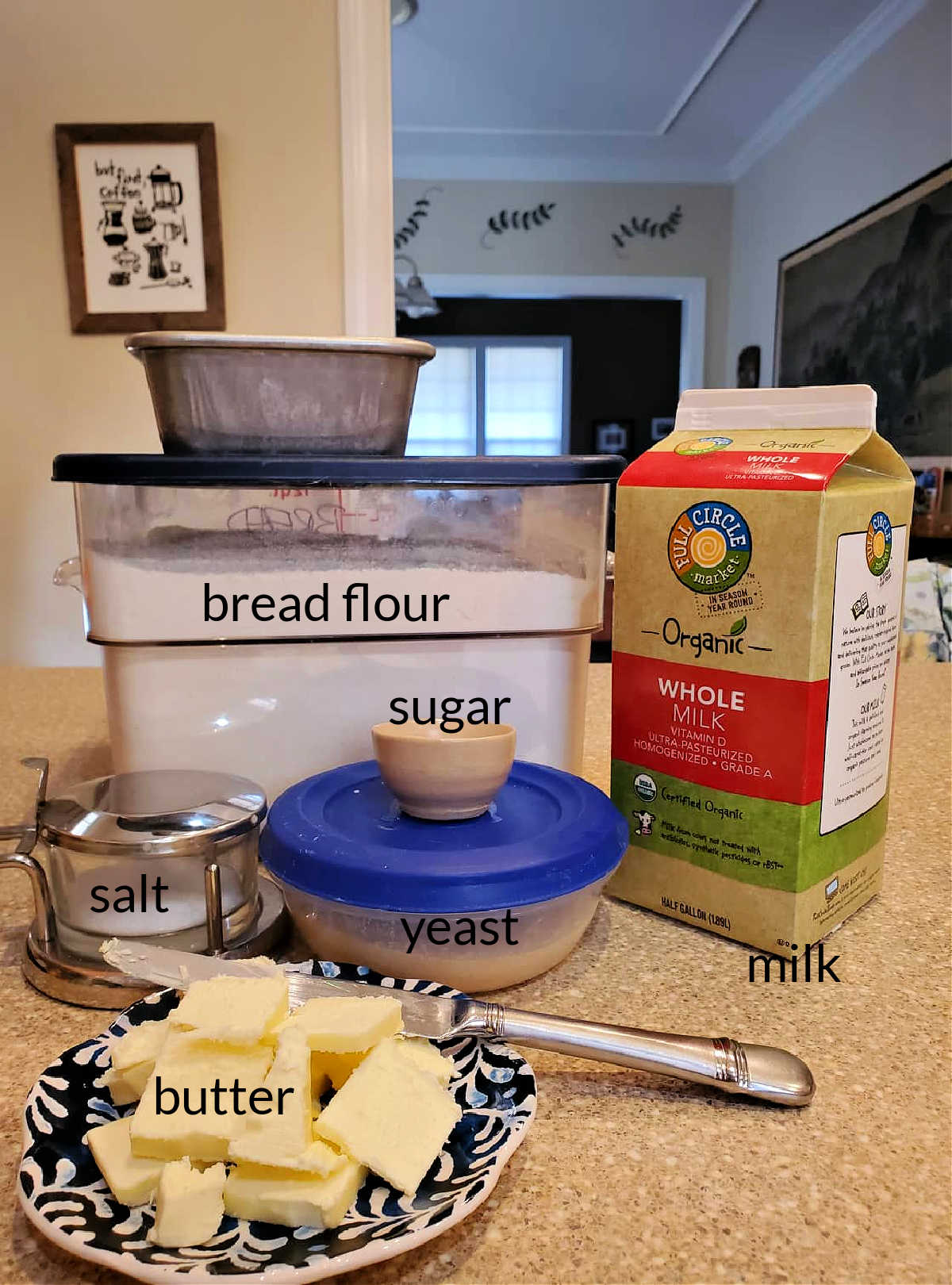
- bread flour: Even though bread flour is used, this loaf isn’t dense and chewy because some of the gluten from the flour is bound up in the roux. Because of this, I recommend sticking with bread flour or at least a higher-gluten all-purpose flour like King Arthur
- milk: I used whole milk. Substitute with 2% or even plant-based milk that doesn’t contain extra thickeners. Note that the bread may not be as sweet since cow milk contains milk sugars
- yeast: I use instant yeast. You may also use active dry yeast. If you do, proof the yeast in a portion of the milk with a teaspoon of the sugar called for. Once it gets foamy, add it to the rest of your ingredients
- salt: Salt adds flavor to the bread as well as helping to control yeast growth so it doesn’t rise too quickly and become “flabby.” Don’t leave it out. I use Morton’s kosher salt.
- sugar: Aside from adding sweetness, sugar also helps tenderize the dough, adds to moistness, and assists in browning. You don’t need much. Between the milk sugars and the table sugar, this bread has a lovely, milky sweetness that works for both sweet and savory sandwiches.
- butter: Fat adds flavor as well as carries other flavors. It also tenderizes the crumb and assists in browning. I use unsalted butter. You can substitute a plant-based butter if you want to make a vegan Tangzhong bread. Note that most plant-based butters are salted, so you will have to cut down on additional salt a bit.
Procedure
- First, you’ll make the tangzhong by whisking together the flour and milk until smooth and then heating until thickened, whisking constantly.
- Add the rest of the milk to cool it down.
- Put it in your mixer bowl and add the rest of the ingredients excep the butter.
- Mix into a shaggy dough, cover the bowl, and let it rest for about 20-30 minutes.
- Knead on medium speed for 10-15 minutes, or until the dough passes the windowpane test.
- Let it rise until doubled.
- Punch down, shape, place it in the pan, and give it another rise.
- Bake until golden brown. The internal temperature should be right around 200F.
- Let cool completely before slicing.
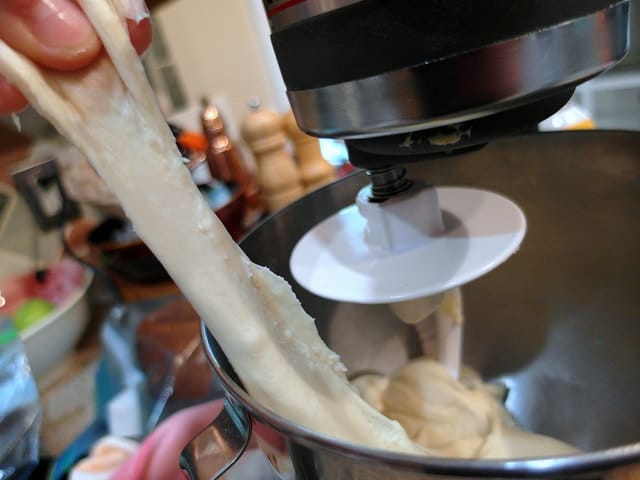
Equipment Recommendation
Since some of the proteins that create the gluten structure are tied up in the tangzhong, it takes awhile for the structure to develop.
In other words, this bread takes a lot of kneading.
For that reason, I recommend making this bread in a
I have a 6-quart KitchenAid that I got from Everything Kitchens, and I love it.
I would not recommend you try to knead this dough using a hand mixer with dough hooks.
Other than the mixer, which granted is a big purchase if you don’t already have one, a bench knife is cheap and useful for all kinds of kitchen tasks.
I use one to help shape this dough, to portion dough for my grits bread burger buns, soft pretzels, and pumpkin dinner rolls, and to scrape dough bits and other scraps off the counter.
Lastly, this recipe fits perfectly into a 9″x5″ loaf pan.
Visual How-To
Here is how to fold your letter-folded dough in half and pinch it together into a long log.
And here’s how to get that log of dough into your pan.
Tips for Success
Be patient and make sure your dough is fully developed to get the best results. You’re making bread with less protein in it, so be sure to knead it until it passes the windowpane test.
For a softer top crust, brush the top of the loaf with about a tablespoon of butter as soon as it comes out of the oven.
How Does Tangzhong Affect the Dough?
Since you’re inhibiting some of the gluten from forming, in essence, you’re working with a dough with an overall lower protein content. And the lower the protein content, the wetter the dough.
High protein flour absorbs more water than low protein flour. This stands to reason since more protein means it needs more water to activate the gluten. And remember, we’ve already made an end run around 5-10% of the gluten by gelatinizing that flour instead.
In short, expect your tangzhong dough to be a bit stickier than standard bread dough.
This type of dough requires a lot more kneading to develop the proteins remaining so your dough stretches the way it needs to. It needs to be kneaded. A lot.
Q & A for the Method and the Bread
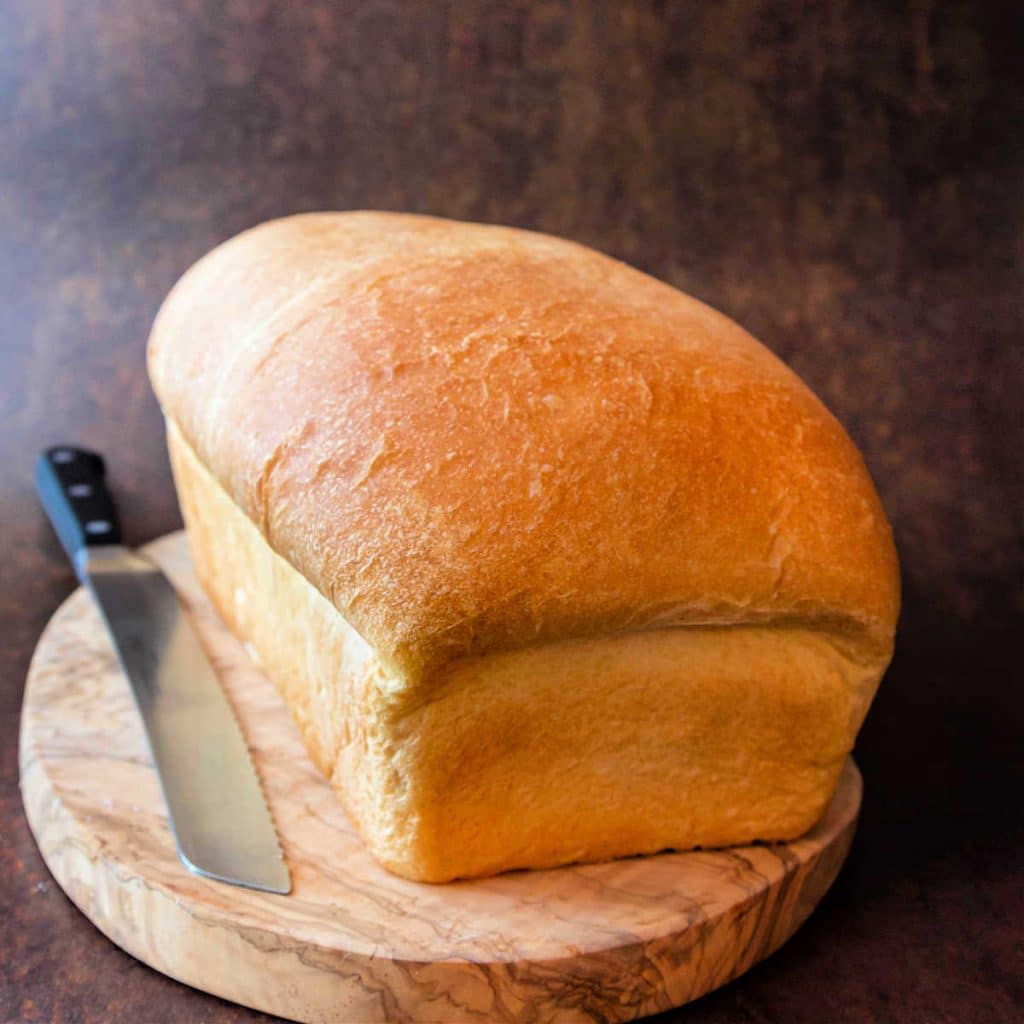
Yes. I found reference to rice flour tang zhong and corn flour (corn starch) tangzhong here on Samayalarai: Cooking is Divine. I have not tried either method, but since, in the case of the wheat flour, the gluten is taken out of the equation leaving only gelatinized starches, it is my guess that there would be very little difference in the texture of the end products.
Yes. Jeanine asked this question of me the other day. I was able to find a delightful looking Gluten Free Japanese Milk Bread by Nicole on Gluten Free on a Shoestring through a thread on The Fresh Loaf.
I would say a qualified yes to this if a)the properties that Tangzhong brings (longer keeping, soft and springy texture, overall lower gluten) are what you’re looking for and b)you realize that you might need to do some tweaking of your formulas to get them to turn out the way you want. For instance, when using other flours that naturally contain less (or no) gluten—rye and oat come to mind—further reducing the gluten by binding up some of your wheat flour in a gel might not give you enough lift. Also, as some mixed flour dough tends to be sticky to begin with, you may end up with soup. So again, I give a qualified yes to this one.
Here’s a link to Swathi’s (Zesty South Indian Kitchen) Rye Bread made with Tangzhong post.
Most of what I have read about Tangzhong is pretty specific. 1:5 is it. But, Stella’s formula calls for a cooked flour starter at a 1:2 ratio: 3oz flour and 6oz water. The resulting water roux has the consistency of mashed potatoes whereas Tangzhong is more akin to pancake batter in texture.
There is always more than one way to skin a cat, and I found reference to several water roux type starters at Shoon Yin’s Recipes, all made a bit differently and all with different ratios of flour to water.
The short answer is yes. Make the starter, spread it out on a plate or put it in a bowl, cover it with plastic wrap and refrigerate up to one day ahead. I would not try to keep it any longer than that as you might start getting some wild yeast fermentation, ending up with more of a sourdough than a true tangzhong bread. Bring the starter back to room temperature before proceeding with your recipe.
If you leave the loaf whole and cut only what you need, the bread should stay soft for up to 4 days out at room temperature. Compare that to standard bread recipes that are really best the day you make them.
Even though it has a longer shelf-life than a standard loaf, if you can’t eat all the bread within 4 days, slice it and freeze it in a zip-top freezer bag (or bags). Press out as much air as you can before sealing. Your bread will stay nice and fresh for as long as 6 months. Thaw at room temperature, or take out frozen slices as needed and thaw in the microwave for a few seconds before using.
Other Tangzhong Bread Recipes
Here are a few other recipes from my site and around the web. The Saffron Bread is lovely, and do check out the other recipes too. You’ll see how versatile this method is. Enjoy!
- Cornish Saffron Bread is a sweetly perfumed Easter bread you might enjoy making
- Tangzhong Whole Wheat and Rye Bread A heartier and more complex loaf than my Tangzhong bread
- Cinnamon Currant Tangzhong Bread Perfect for toasting for breakfast or brunch!
- Hokkaido Milk Bread A classic Japanese bread that gets its tenderness and gossamer crumb from the shaping method as well as the Tangzhong
Questions
Serving Suggestions
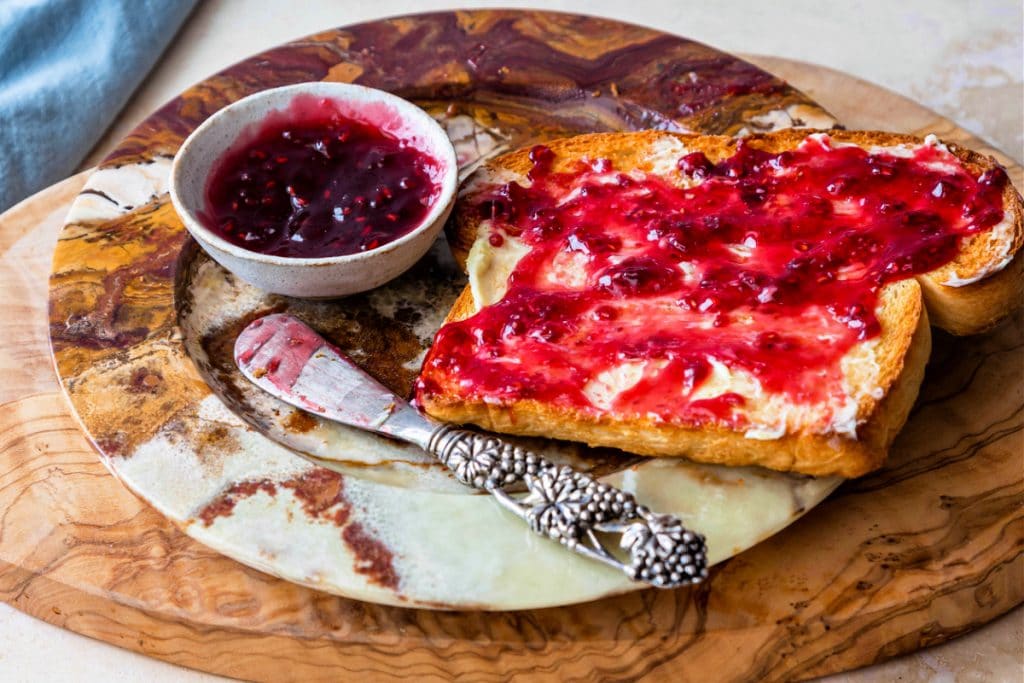
Obviously, you have to make toast with butter and jam! Might I suggest my mixed berry jam or fig jam?
Make a great BLT sandwich. Or pile on some coronation chicken salad.
You can also use it for bread crumbs to top gratins or bread chicken. It would also be a great addition to a meatloaf like this chorizo meatloaf or an old-fashioned beef meatloaf.
A Note About Measurements
NOTE: Most of my recipes are written by weight and not volume, even the liquids.
Even though I try to provide you with volume measurements as well, I encourage you to buy a kitchen scale for ease of measuring, accuracy, and consistency. Especially for bread since volume measurements of flour can vary widely
This is the scale I use, love, and recommend:
Don't let its small price and small size fool you. The Escali Primo is an accurate and easy-to-use food scale that I have used for years. It's easy to store, easy to use, has a tare function, and easily switches between grams and ounces/pounds for accurate measurements.
It will help me and other readers so much if you take a moment to rate and leave a review for this recipe.
You can use the stars to rate 1-5 (5 is best), and leave a review in the comments. It helps me make adjustments if any are needed, and comments help others decide whether the recipe is worth making.
Other ways to share include pinning, and/or sharing on your favorite social media platform.
Thank you so much for taking the time!

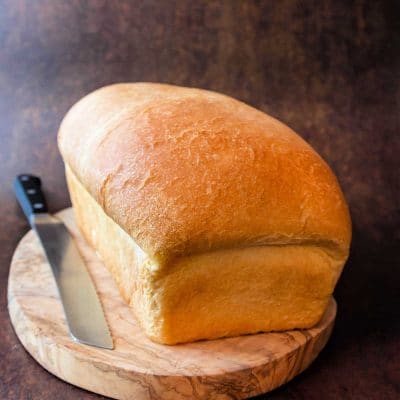
Pain au Lait using Tangzhong method
Ingredients
For the Tangzhong
- 6 oz whole milk
- 1.2 oz bread flour
For the Dough
- All the Tangzhong
- 6 oz . whole milk
- 15.8 oz bread flour
- 4 teaspoons granulated sugar
- 1 ¼ teaspoons active dry yeast (from a batch of yeast you know is alive and kicking)
- 1 ⅛ teaspoon 7 grams kosher salt (picky, but there you have it), (I used Morton’s)
- 3.25 oz butter cut into small pieces and allowed to get very soft
Instructions
For the Tangzhong
- Whisk together the flour and milk.
- Once there are no lumps remaining, cook over medium heat, whisking constantly, until the mixture has evenly thickened and is nice and smooth.
- Remove from the heat and…
For the Bread
- pour the 6 oz of milk into the Tangzhong, whisking until smooth. This will lower the temperature so you don't have to wait before continuing.
- To your mixing bowl, add all the tangzhong/milk mixture and all the rest of the ingredients except for the butter.
- With the dough hook, mix on low speed for one minute, or until the dough just comes together. There might be some loose flour in the bowl, but don't worry about it. It will get incorporated in the next step when you add the butter.
- Cover the mixer bowl with a lint-free towel (you can leave the bowl on the mixer) and let rest for 30 minutes. This rest (autolyse) allows some gluten to form before you even start kneading.
- After the rest, turn the mixer on medium-low speed and add the butter in several additions over the course of about three minutes. By the time the butter is incorporated, you should have a nice, slightly sticky dough.
- Turn the mixer on medium speed and knead for 10 minutes.
- Test the dough to see if it is smooth and stretchy and passes the windowpane test.
- If not, knead an additional 5 minutes and check again.
- Once the dough passes the windowpane test, gather it into a smooth ball, plop it back into the mixer bowl and spray with pan spray. Cover the bowl with a lint-free towel.
- Boil a mug of water in the microwave, move it to one side, and let the dough hang out in the moist, warm microwave until doubled, about an hour or so.
- Once the dough has doubled, turn it out onto a clean work surface–no flour. Lightly press the dough into a rough 9" square.
Shaping
- Fold the dough into thirds like a letter. Then, fold it in half–it will seem an impossible task, but just start at one side and sort of push the dough down in the center of your letter fold and pinch the top and bottom edges together. Keep doing this all the way down the length of your dough. Now you will have a fat cylinder of dough about a foot long.
- Roll the dough over (smooth side up) and hold it like a bowed up slinky.
- Fit the dough into a pan-sprayed 9"x5" loaf pan so the slinky's ends are down in the bottom of the pan. Then press the dough down a bit to even it out and allow it to sit snugly in the pan.
- Heat the mug of water for another minute or so, and spray the top of the loaf with pan spray.
- Cover with plastic wrap and place back in the cozy microwave with its little mug friend.
- Go ahead and set a rack in the center of the oven and preheat to 350F.
- Let the loaf rise until it has not quite doubled in size–it will probably rise about an inch or so above the lip of the loaf pan. This will take about 30-45 minutes.
- Once the dough has risen nicely, place in the preheated oven and bake until the loaf is a deep golden brown. It doesn't need any egg wash or anything. The loaf should sound hollow when tapped and the internal temperature will be between 205F and 210F.
- Tip the bread out of the pan and onto a wire rack to cool. Let cool at least an hour if you can. If you can't, I'll understand. Your bread will have a better texture if you let it cool first, though. Hot bread sort of turns to mush in your mouth since the starches need to cool down to about 140F to solidify. Cutting too soon can result in smooshed and smooshy bread.
- Store at room temperature in an airtight container for 3-4 days. For longer storage, pre-slice, wrap well and freeze. Pull out slices as needed and leave the rest frozen.
Did You Make Any Changes?
Notes
Nutrition

Hi, y’all! I hope you’ve enjoyed this post and hopefully also learned a thing or two.
If you like my style, I invite you to sign up for my occasional newsletter, The Inbox Pastry Chef.
Expect updates on new and tasty recipes as well as a bit of behind-the-scenes action. I hope to see you there!
Thanks for spending a (large) part of your day with me, and have a lovely day.



Join in Today!
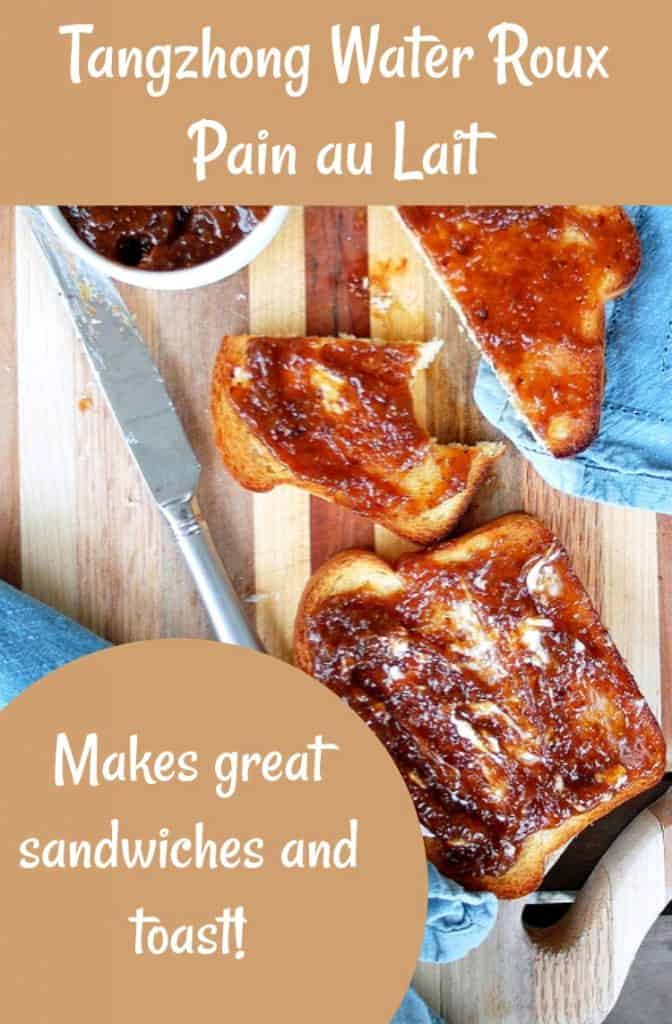
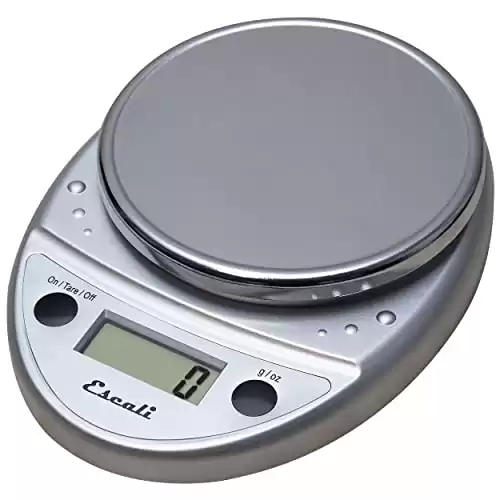
I have trouble getting the flour and water/milk lump free. Would it work just as well if I combined melted butter and flour, mix them together and then added the water/milk? Much like making a white sauce.
I’ve not tried it that way, but it sounds promising. Still, I’ve never had the lumps issue before. Make sure to whisk the milk and flour together while cold and then heat them together to avoid lumps.
Hi! Have you read the tangzhong blog on King Arthur website? The author stated that when you use tangzhong you should up the hydration of dough recipe to 75%. Have you tried this or have you found that not necessary? A lot of sweet dough recipe I see has very low hydration of 55-60%. I’m thinking of using tangzhong for it.
Hey, Kimmy. This is a really good question. Yes, I have read that post, but in my experience, I didn’t find it necessary to add extra liquid. I just did the math to use what I needed in the tangzhong and added the rest directly to the dough. I don’t think it’s a bad idea to up the hydration, regardless. Many breads benefit from additional liquid, often because people just tend to err on the side of too dry a dough because of the stickiness factor. Tangzhong doughs are, by nature, more sticky than traditional dough, so upping the liquid by a bit more will just make it stickier. On the plus side, your mixer is your friend here, as are oiled hands. I tend to make breads with hydration of at least 65% or so (usually), so I can’t see that upping that to 75% would be a problem as long as you know what to expect, stickiness-wise. Hope that helps!
Hi Jennie
I have done this tangzhong technique and encounter small holes on the surface of the dough, does it mean the dough is not kneaded enough , it is very sticky and hard to shape
Thanks
Nena
Tangzhong dough, because less gluten can form, is by nature very sticky. It also benefits from a long knead or a combination of kneading (by machine) for a few minutes and resting the dough for 20-30 minutes in between. Once it is smooth it will still be somewhat sticky, so oil your hands in order to shape it with minimal sticking. I hope that helps!
Just got into baking bread during this pandemic! I am absolutely possessed! What a great explanation and directions of tangzhong method! Thank you so much for sharing. You have me feeling, “This cornbread and tortilla girl in South Texas can do this!”
Yes you can, J Rose!! It’s a great method! I have more recently begun exploring adding other gelatinized starches to bread as a “short cut tangzhong method,” because I believe adding cooked potato to bread dough is pretty much the same and cooking some of the flour and water together. They both serve the same purpose. And if you’re a cornbread and tortilla girl, keep an eye out. I’m going to have a loaf up on the blog soon that starts with cooked grits! Super good! Take care and stay safe, and thank you for commenting. Let me know how your adventures in tangzhong go! 🙂
Hi there, I just found you and your site while looking up good soft sandwich bread and love your energy and style. Thank you for the awesome recipe, also, I heard of this method for baking bread but thought it was just for milk bread. I was wondering if you heard of the Yudane method which uses much more of the flour and boiling water added to the flour, letting it cool then refrigerate four 4 hours before making the bread. I found out about this method here https://www.thebreadshebakes.com/2019/03/homemade-japanese-milk-bread-loaf-recipe-shokupan/ she has a very good explanation of the two methods.
I haven’t, but I will be reading this post. Thank you! I’m so glad you stopped in to say howdy and to teach me something!
Hi there, I have a general question about tangzhong. Is there any benefit of letting it sit overnight in the fridge? I found recipes that ask for that whereas others just tell you to let it cool down completely and then use it (after maybe a couple hours max).
Does a long resting period change the flavor or does it in any way change the outcome? I can not find an answer to that anywhere but maybe you know?
Thanks!
Hey Bianca. I would say that there is minimal benefit. I do not know the answer to your question For Sure, but the tangzhong is fully gelatinized on the stove, so no need to let it sit in the fridge overnight for hydration purposes. And the gelatinization keeps the proteins from forming gluten, so no need for it to hang out for gluten to develop either. I usually just wait until the mixture is at room temp. Hope this helps!
I have come to the Tangzhong technique even later, just last fall actually. Fascinating!
Your article on this is very helpful and explains the science (the why) behind the process. I also found some very good information on the King Arthur Flour website (https://blog.kingarthurflour.com/2018/03/26/introduction-to-tangzhong/ and related/linked articles). They did a study that brings up an important point to consider, hydration level. Their study shows needing a certain hydration level to get the best benefit of the Tangzhong technique.
Your example using a Pain au Lait recipe gave you a head start since it already had a 70% hydration. That reduced the math and fiddling with the recipe. Other breads will need adjustments.
I would agree that your initial blandness of the first loaf was just the substitution of water for some of the milk. I have had exactly that result in experiments. Some breads need that milk. Water doesn’t do it for certain loaves.
Tangzhong has certainly improved several of my breads. It softens rye blends. It seems to help increase the overall and useful life of the finished bread, staying moist and soft much longer rather than turning stale and hard in a very short period of time. This gives storage options and increases the applause from tasters.
I’m not sure yet how it is affecting the size of the holes in the crumb. I’ll need to do some loaves without rye in them to check that. Rye tends to stay low and small.
Using sourdough starter in a dough with a Tangzhong approach does work deliciously too.
While it is usually best to give a dough plenty of time (but not too much!) to rise slowly and develop more flavor, sometimes one does not have that luxury. Your separate mug boil and then snuggle it with the dough approach is one way to speed things up. I have been using another one lately called No-Time Bread: https://www.thekitchn.com/easier-no-knead-bread-in-a-hurry-40653 (one example). This does involve microwaving the actual dough in a microwave-safe bowl with a damp cloth on top. But it does speed up the process when necessary. So many paths.
Thank you for a very informative and helpful article. Sharing discoveries helps us all improve.
Hi, John, and thank you so much for this comment and the links to further resources! So much to know, we all should be learning all the time! Here’s another nugget I’ve picked up along the way: a friend of mine uses Tangzhong with gluten-free breads, believe it or not, and she has had excellent results. It’s a great technique to have in your back pocket.
I have read the KA article about adding additional liquid for some of the formulas, and I believe Stella Parks has also addressed this in a Serious Eats column (I think). I have never had the issue, but you could be right. It could be that I’m already starting with a bread with a pretty high hydration. And I guess it stands to reason that with a “firmer” dough/lower hydration, having a certain percentage bound up with the starch would necessitate additional liquid to actually activate the gluten in the remainder of the flour and allow us to end up with a workable dough that has enough “give” to actually rise.
Thanks again, for taking the time to comment. Will have to give sourdough a go at some point, too!
Hi. I made this bread today and I have to say your directions are excellent, though I did have a bit of a problem with that last fold. However, I made it work. The last rise probably took about an hour. After the dough ingredients are all incorporated it’s very similar to making artisanal bread – the way the dough stretches, the windowpane check, forming the loaf, etc. I’ve been making bread for about 50 years and am always looking for different methods, types of bread. I usually make sourdough so I may incorporate the tangzhong method in that. Thanks for introducing this bread and making this recipe/method easy.
Thanks so much for commenting, Jan! Glad you made it work–that’s what it’s all about! Glad I could help expand your bread making repertoire! It’s such a cool technique and makes such a difference in softness and keepability. I hope you end up enjoying many, many more loaves. I have a gluten free baking friend who even uses the method with gluten free breads, so the technique is applicable across almost any bread you can imagine. Have fun!
Holy moly. that was a lot of work to write this post! I’m thinking the actual bread making is way easier. And now I want a pb&j sandwich!
LOL, yes, I promise it’s way easier to make the bread than it is to read the post! And this is a great choice for a PB&J! 🙂
Are you aware that your photos all disappeared?
No, but I do now! Thanks for letting me know–I will see if I can find them and re-appear them. In the meantime, I hope you try the bread. 🙂
Seriously, I appreciate the heads up!
I know this comment comes late but I made this last night and it is very bland. Not enough salt. In bread baking, salt plays two roles, taste and strengthening the gluten. Also, if you are using an autolyze it should be ~before~ the salt is added.
Thanks for your comment. I agree that there is relatively little salt in this dough. That is because I was more interested in making an excellent sandwich bread that would take a back seat to all the ingredients you’d put on a sandwich. For just “straight up” eating, perhaps more salt would be in order. As to the rest, you do as you see fit and as your training/education has taught you. Personally, I love the final outcome, but to each his own. Sorry you didn’t love the loaf. Next time, feel free to apply bakers’ percentages and add your preferred amount of salt. Again, thank you for stopping in.